Individual Critical Analysis Report: Healthcare in India (Economics)
VerifiedAdded on 2022/12/29
|10
|1741
|60
Report
AI Summary
This report critically analyzes the Indian healthcare system, emphasizing the equity gap in access and availability of healthcare resources. It examines the challenges, including accessibility issues in rural areas, and discusses strategies like e-health initiatives to bridge the gap and meet Sustainable Development Goals (SDGs). The report highlights the role of government schemes, digital infrastructure, and telemedicine in improving healthcare outcomes. It recommends surveys to understand the situation better, digitalizing healthcare management, and promoting healthcare insurance plans. The conclusion emphasizes the importance of overcoming barriers to successfully implement e-health strategies, with the goal of enhancing the quality of service and patient outcomes.
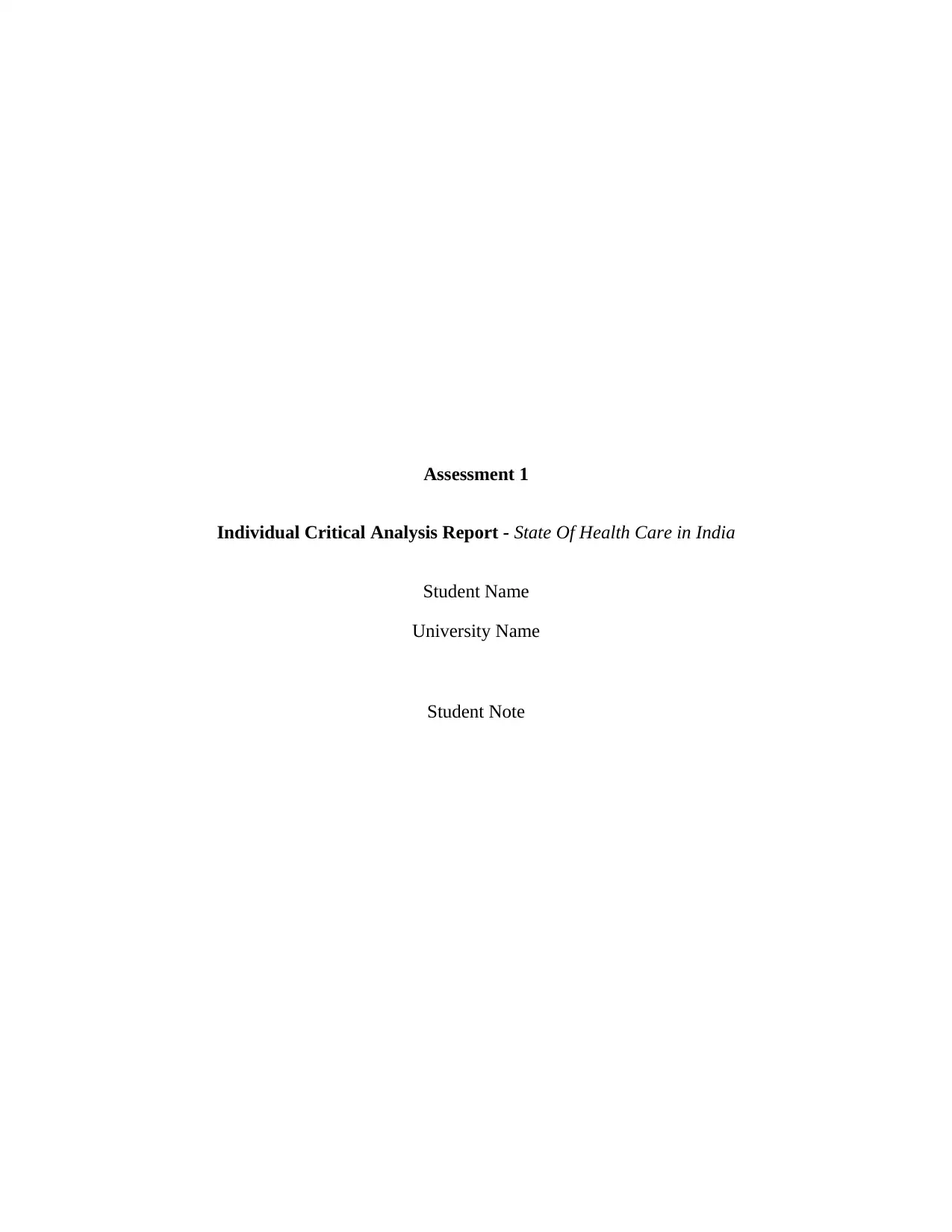
Assessment 1
Individual Critical Analysis Report - State Of Health Care in India
Student Name
University Name
Student Note
Individual Critical Analysis Report - State Of Health Care in India
Student Name
University Name
Student Note
Paraphrase This Document
Need a fresh take? Get an instant paraphrase of this document with our AI Paraphraser
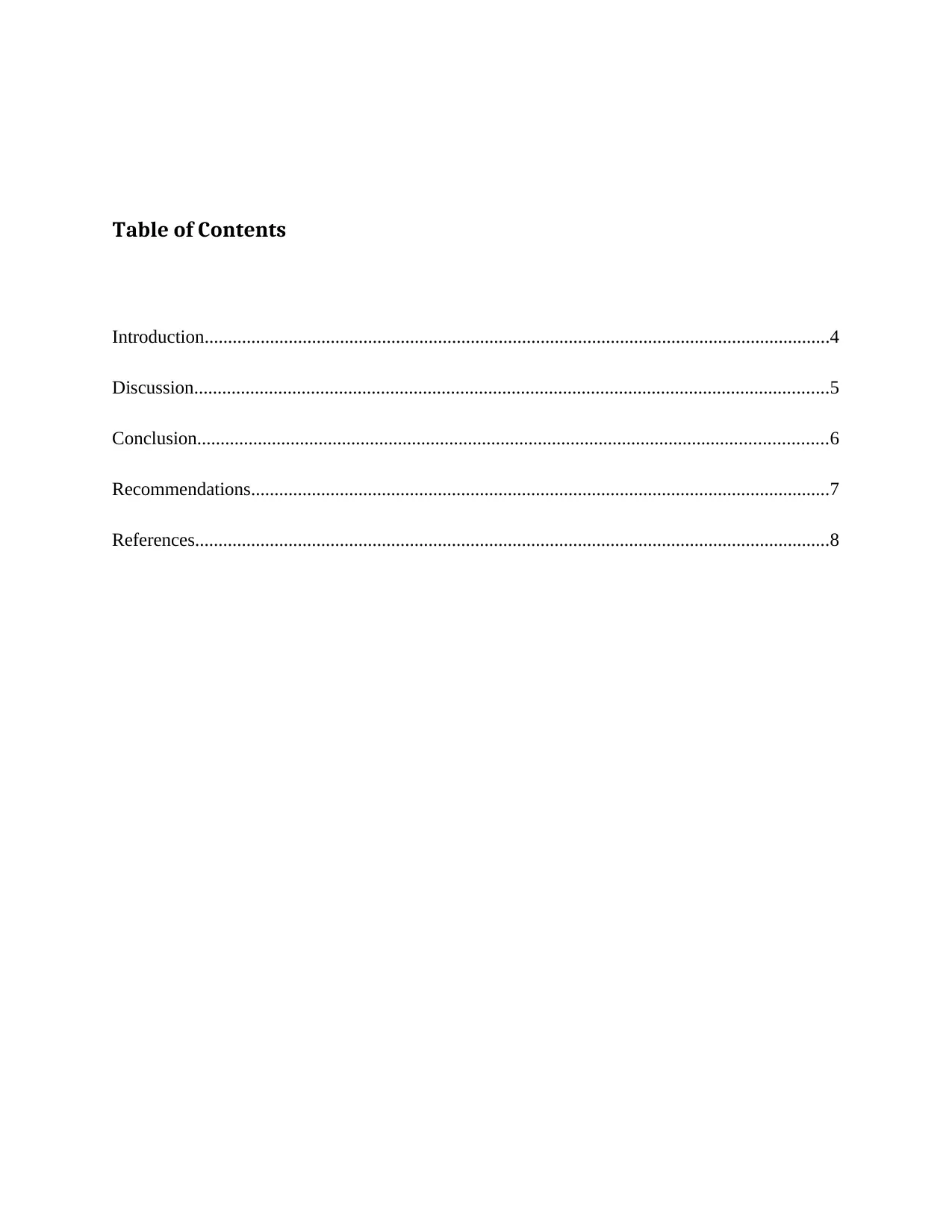
Table of Contents
Introduction......................................................................................................................................4
Discussion........................................................................................................................................5
Conclusion.......................................................................................................................................6
Recommendations............................................................................................................................7
References........................................................................................................................................8
Introduction......................................................................................................................................4
Discussion........................................................................................................................................5
Conclusion.......................................................................................................................................6
Recommendations............................................................................................................................7
References........................................................................................................................................8
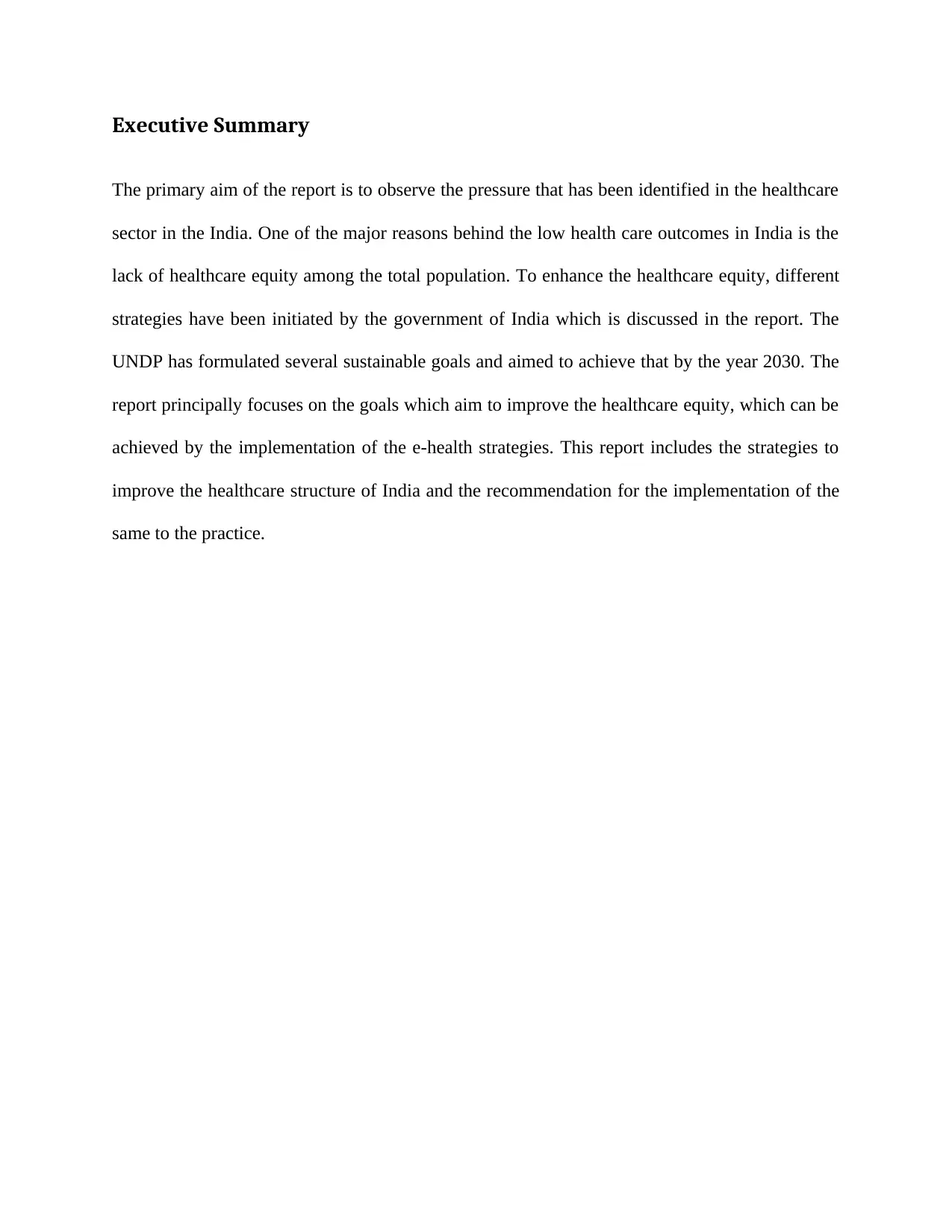
Executive Summary
The primary aim of the report is to observe the pressure that has been identified in the healthcare
sector in the India. One of the major reasons behind the low health care outcomes in India is the
lack of healthcare equity among the total population. To enhance the healthcare equity, different
strategies have been initiated by the government of India which is discussed in the report. The
UNDP has formulated several sustainable goals and aimed to achieve that by the year 2030. The
report principally focuses on the goals which aim to improve the healthcare equity, which can be
achieved by the implementation of the e-health strategies. This report includes the strategies to
improve the healthcare structure of India and the recommendation for the implementation of the
same to the practice.
The primary aim of the report is to observe the pressure that has been identified in the healthcare
sector in the India. One of the major reasons behind the low health care outcomes in India is the
lack of healthcare equity among the total population. To enhance the healthcare equity, different
strategies have been initiated by the government of India which is discussed in the report. The
UNDP has formulated several sustainable goals and aimed to achieve that by the year 2030. The
report principally focuses on the goals which aim to improve the healthcare equity, which can be
achieved by the implementation of the e-health strategies. This report includes the strategies to
improve the healthcare structure of India and the recommendation for the implementation of the
same to the practice.
⊘ This is a preview!⊘
Do you want full access?
Subscribe today to unlock all pages.

Trusted by 1+ million students worldwide
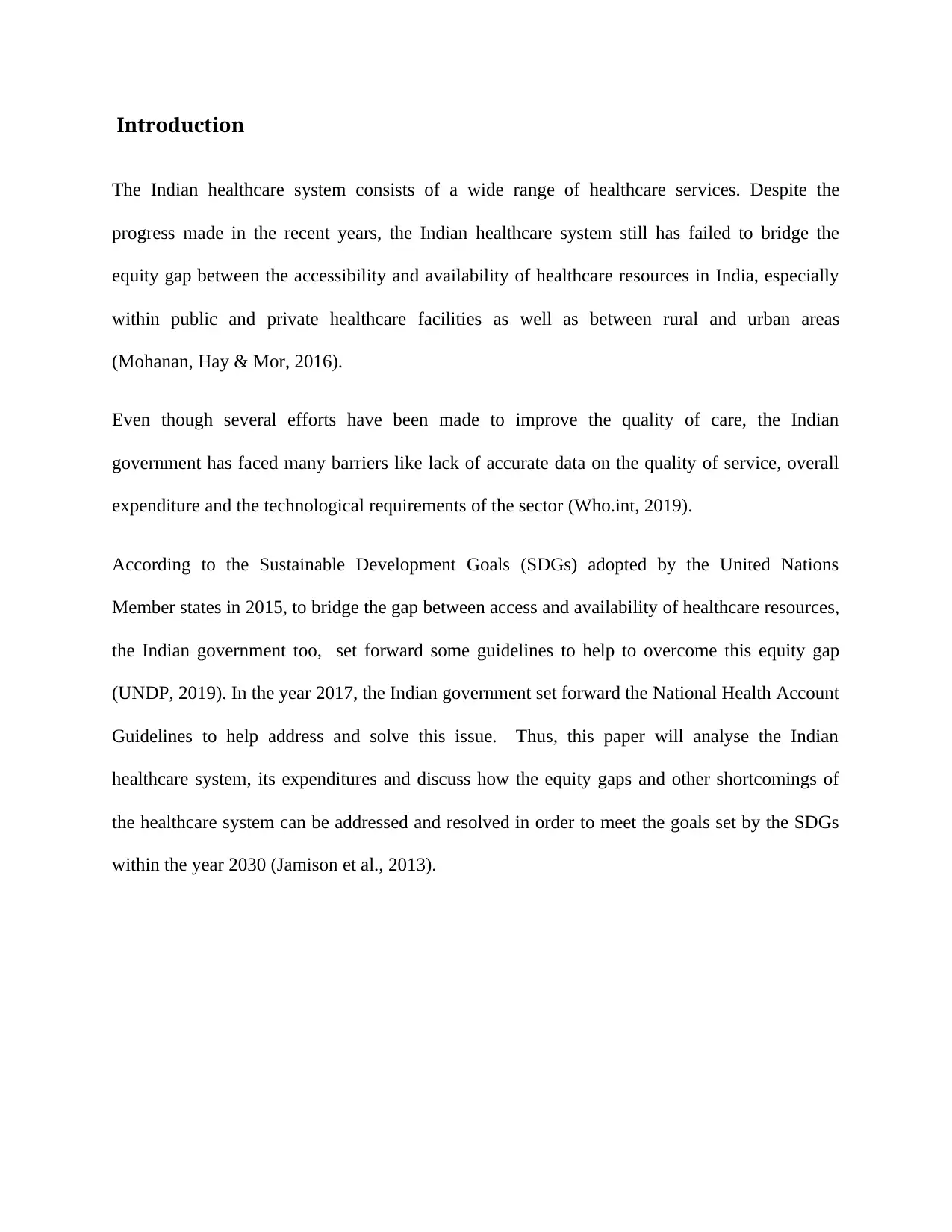
Introduction
The Indian healthcare system consists of a wide range of healthcare services. Despite the
progress made in the recent years, the Indian healthcare system still has failed to bridge the
equity gap between the accessibility and availability of healthcare resources in India, especially
within public and private healthcare facilities as well as between rural and urban areas
(Mohanan, Hay & Mor, 2016).
Even though several efforts have been made to improve the quality of care, the Indian
government has faced many barriers like lack of accurate data on the quality of service, overall
expenditure and the technological requirements of the sector (Who.int, 2019).
According to the Sustainable Development Goals (SDGs) adopted by the United Nations
Member states in 2015, to bridge the gap between access and availability of healthcare resources,
the Indian government too, set forward some guidelines to help to overcome this equity gap
(UNDP, 2019). In the year 2017, the Indian government set forward the National Health Account
Guidelines to help address and solve this issue. Thus, this paper will analyse the Indian
healthcare system, its expenditures and discuss how the equity gaps and other shortcomings of
the healthcare system can be addressed and resolved in order to meet the goals set by the SDGs
within the year 2030 (Jamison et al., 2013).
The Indian healthcare system consists of a wide range of healthcare services. Despite the
progress made in the recent years, the Indian healthcare system still has failed to bridge the
equity gap between the accessibility and availability of healthcare resources in India, especially
within public and private healthcare facilities as well as between rural and urban areas
(Mohanan, Hay & Mor, 2016).
Even though several efforts have been made to improve the quality of care, the Indian
government has faced many barriers like lack of accurate data on the quality of service, overall
expenditure and the technological requirements of the sector (Who.int, 2019).
According to the Sustainable Development Goals (SDGs) adopted by the United Nations
Member states in 2015, to bridge the gap between access and availability of healthcare resources,
the Indian government too, set forward some guidelines to help to overcome this equity gap
(UNDP, 2019). In the year 2017, the Indian government set forward the National Health Account
Guidelines to help address and solve this issue. Thus, this paper will analyse the Indian
healthcare system, its expenditures and discuss how the equity gaps and other shortcomings of
the healthcare system can be addressed and resolved in order to meet the goals set by the SDGs
within the year 2030 (Jamison et al., 2013).
Paraphrase This Document
Need a fresh take? Get an instant paraphrase of this document with our AI Paraphraser
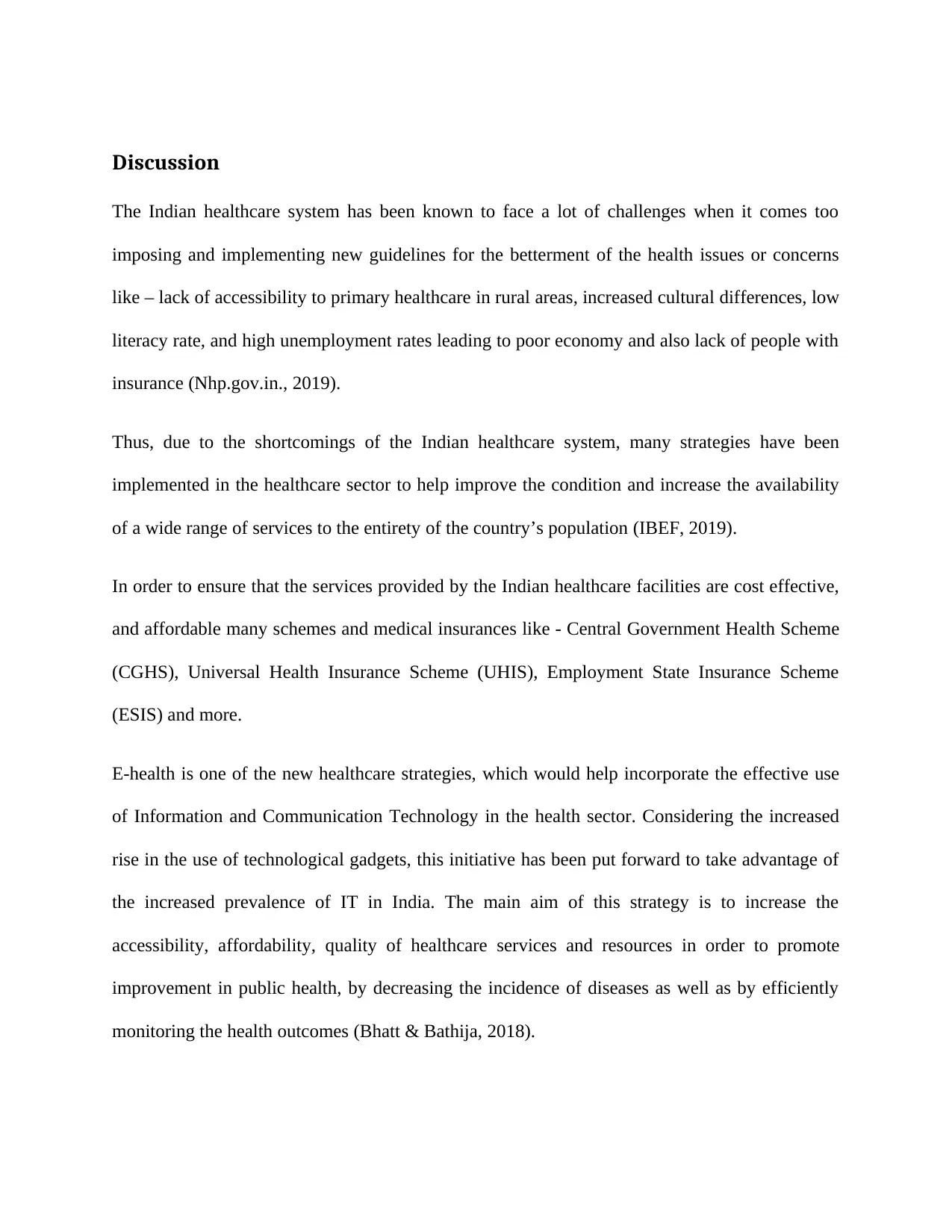
Discussion
The Indian healthcare system has been known to face a lot of challenges when it comes too
imposing and implementing new guidelines for the betterment of the health issues or concerns
like – lack of accessibility to primary healthcare in rural areas, increased cultural differences, low
literacy rate, and high unemployment rates leading to poor economy and also lack of people with
insurance (Nhp.gov.in., 2019).
Thus, due to the shortcomings of the Indian healthcare system, many strategies have been
implemented in the healthcare sector to help improve the condition and increase the availability
of a wide range of services to the entirety of the country’s population (IBEF, 2019).
In order to ensure that the services provided by the Indian healthcare facilities are cost effective,
and affordable many schemes and medical insurances like - Central Government Health Scheme
(CGHS), Universal Health Insurance Scheme (UHIS), Employment State Insurance Scheme
(ESIS) and more.
E-health is one of the new healthcare strategies, which would help incorporate the effective use
of Information and Communication Technology in the health sector. Considering the increased
rise in the use of technological gadgets, this initiative has been put forward to take advantage of
the increased prevalence of IT in India. The main aim of this strategy is to increase the
accessibility, affordability, quality of healthcare services and resources in order to promote
improvement in public health, by decreasing the incidence of diseases as well as by efficiently
monitoring the health outcomes (Bhatt & Bathija, 2018).
The Indian healthcare system has been known to face a lot of challenges when it comes too
imposing and implementing new guidelines for the betterment of the health issues or concerns
like – lack of accessibility to primary healthcare in rural areas, increased cultural differences, low
literacy rate, and high unemployment rates leading to poor economy and also lack of people with
insurance (Nhp.gov.in., 2019).
Thus, due to the shortcomings of the Indian healthcare system, many strategies have been
implemented in the healthcare sector to help improve the condition and increase the availability
of a wide range of services to the entirety of the country’s population (IBEF, 2019).
In order to ensure that the services provided by the Indian healthcare facilities are cost effective,
and affordable many schemes and medical insurances like - Central Government Health Scheme
(CGHS), Universal Health Insurance Scheme (UHIS), Employment State Insurance Scheme
(ESIS) and more.
E-health is one of the new healthcare strategies, which would help incorporate the effective use
of Information and Communication Technology in the health sector. Considering the increased
rise in the use of technological gadgets, this initiative has been put forward to take advantage of
the increased prevalence of IT in India. The main aim of this strategy is to increase the
accessibility, affordability, quality of healthcare services and resources in order to promote
improvement in public health, by decreasing the incidence of diseases as well as by efficiently
monitoring the health outcomes (Bhatt & Bathija, 2018).
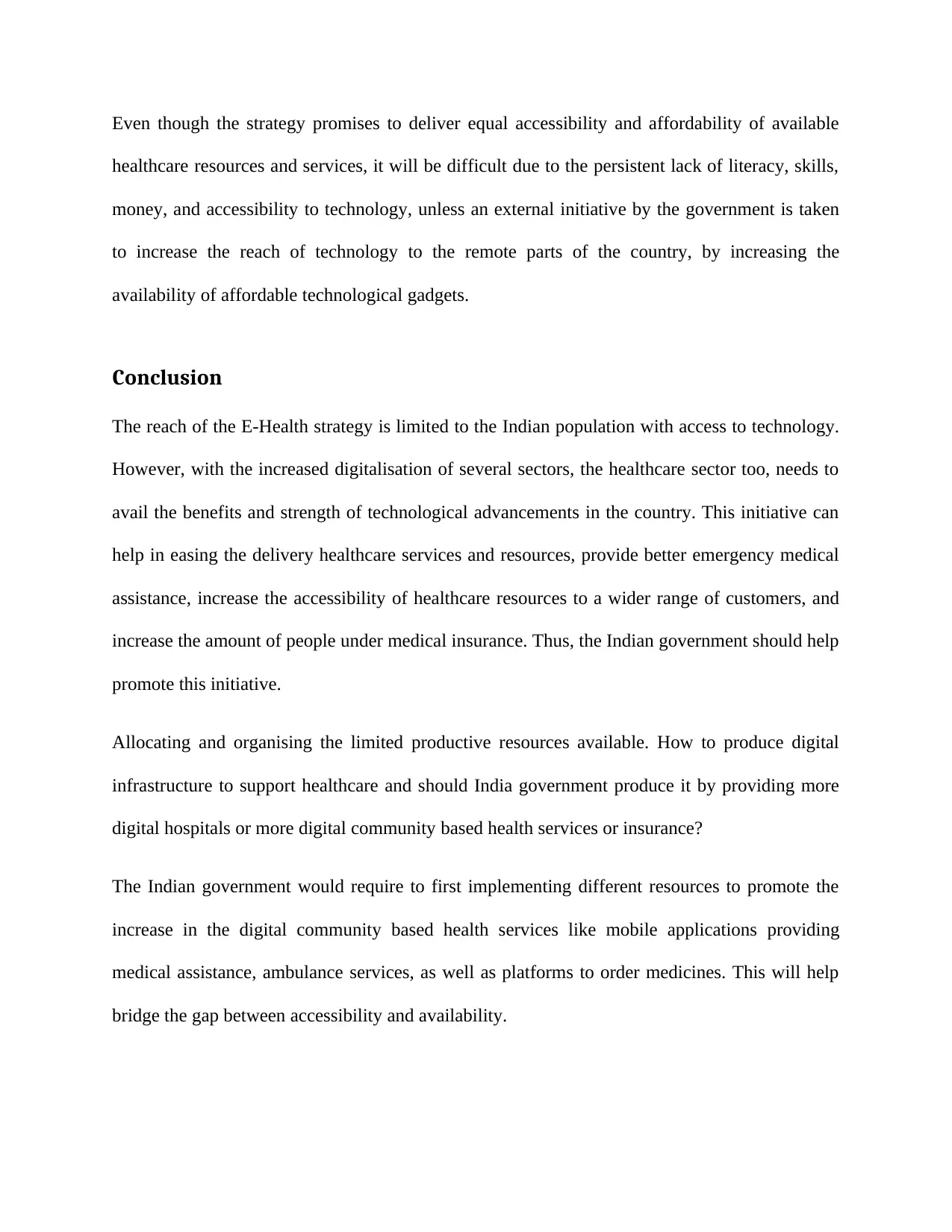
Even though the strategy promises to deliver equal accessibility and affordability of available
healthcare resources and services, it will be difficult due to the persistent lack of literacy, skills,
money, and accessibility to technology, unless an external initiative by the government is taken
to increase the reach of technology to the remote parts of the country, by increasing the
availability of affordable technological gadgets.
Conclusion
The reach of the E-Health strategy is limited to the Indian population with access to technology.
However, with the increased digitalisation of several sectors, the healthcare sector too, needs to
avail the benefits and strength of technological advancements in the country. This initiative can
help in easing the delivery healthcare services and resources, provide better emergency medical
assistance, increase the accessibility of healthcare resources to a wider range of customers, and
increase the amount of people under medical insurance. Thus, the Indian government should help
promote this initiative.
Allocating and organising the limited productive resources available. How to produce digital
infrastructure to support healthcare and should India government produce it by providing more
digital hospitals or more digital community based health services or insurance?
The Indian government would require to first implementing different resources to promote the
increase in the digital community based health services like mobile applications providing
medical assistance, ambulance services, as well as platforms to order medicines. This will help
bridge the gap between accessibility and availability.
healthcare resources and services, it will be difficult due to the persistent lack of literacy, skills,
money, and accessibility to technology, unless an external initiative by the government is taken
to increase the reach of technology to the remote parts of the country, by increasing the
availability of affordable technological gadgets.
Conclusion
The reach of the E-Health strategy is limited to the Indian population with access to technology.
However, with the increased digitalisation of several sectors, the healthcare sector too, needs to
avail the benefits and strength of technological advancements in the country. This initiative can
help in easing the delivery healthcare services and resources, provide better emergency medical
assistance, increase the accessibility of healthcare resources to a wider range of customers, and
increase the amount of people under medical insurance. Thus, the Indian government should help
promote this initiative.
Allocating and organising the limited productive resources available. How to produce digital
infrastructure to support healthcare and should India government produce it by providing more
digital hospitals or more digital community based health services or insurance?
The Indian government would require to first implementing different resources to promote the
increase in the digital community based health services like mobile applications providing
medical assistance, ambulance services, as well as platforms to order medicines. This will help
bridge the gap between accessibility and availability.
⊘ This is a preview!⊘
Do you want full access?
Subscribe today to unlock all pages.

Trusted by 1+ million students worldwide
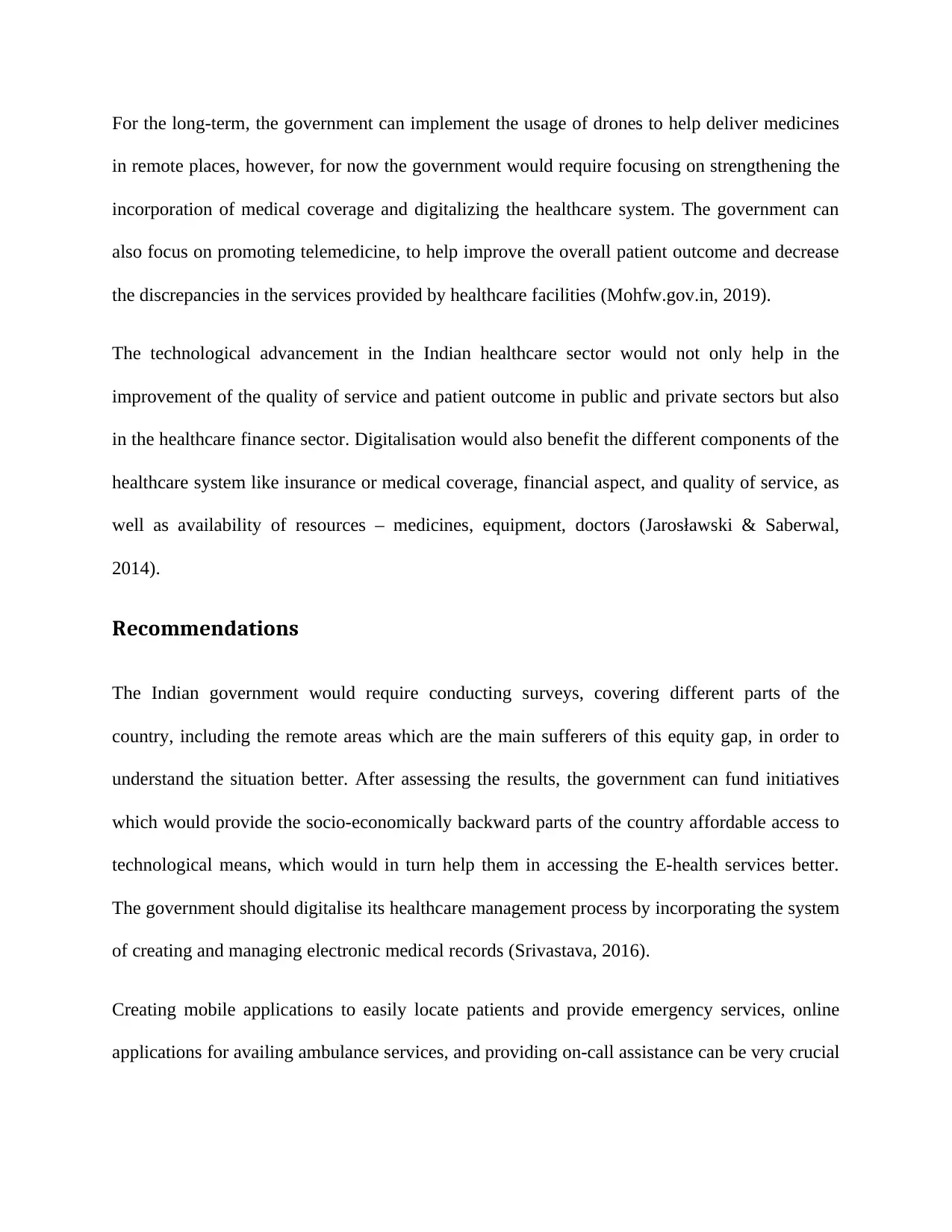
For the long-term, the government can implement the usage of drones to help deliver medicines
in remote places, however, for now the government would require focusing on strengthening the
incorporation of medical coverage and digitalizing the healthcare system. The government can
also focus on promoting telemedicine, to help improve the overall patient outcome and decrease
the discrepancies in the services provided by healthcare facilities (Mohfw.gov.in, 2019).
The technological advancement in the Indian healthcare sector would not only help in the
improvement of the quality of service and patient outcome in public and private sectors but also
in the healthcare finance sector. Digitalisation would also benefit the different components of the
healthcare system like insurance or medical coverage, financial aspect, and quality of service, as
well as availability of resources – medicines, equipment, doctors (Jarosławski & Saberwal,
2014).
Recommendations
The Indian government would require conducting surveys, covering different parts of the
country, including the remote areas which are the main sufferers of this equity gap, in order to
understand the situation better. After assessing the results, the government can fund initiatives
which would provide the socio-economically backward parts of the country affordable access to
technological means, which would in turn help them in accessing the E-health services better.
The government should digitalise its healthcare management process by incorporating the system
of creating and managing electronic medical records (Srivastava, 2016).
Creating mobile applications to easily locate patients and provide emergency services, online
applications for availing ambulance services, and providing on-call assistance can be very crucial
in remote places, however, for now the government would require focusing on strengthening the
incorporation of medical coverage and digitalizing the healthcare system. The government can
also focus on promoting telemedicine, to help improve the overall patient outcome and decrease
the discrepancies in the services provided by healthcare facilities (Mohfw.gov.in, 2019).
The technological advancement in the Indian healthcare sector would not only help in the
improvement of the quality of service and patient outcome in public and private sectors but also
in the healthcare finance sector. Digitalisation would also benefit the different components of the
healthcare system like insurance or medical coverage, financial aspect, and quality of service, as
well as availability of resources – medicines, equipment, doctors (Jarosławski & Saberwal,
2014).
Recommendations
The Indian government would require conducting surveys, covering different parts of the
country, including the remote areas which are the main sufferers of this equity gap, in order to
understand the situation better. After assessing the results, the government can fund initiatives
which would provide the socio-economically backward parts of the country affordable access to
technological means, which would in turn help them in accessing the E-health services better.
The government should digitalise its healthcare management process by incorporating the system
of creating and managing electronic medical records (Srivastava, 2016).
Creating mobile applications to easily locate patients and provide emergency services, online
applications for availing ambulance services, and providing on-call assistance can be very crucial
Paraphrase This Document
Need a fresh take? Get an instant paraphrase of this document with our AI Paraphraser
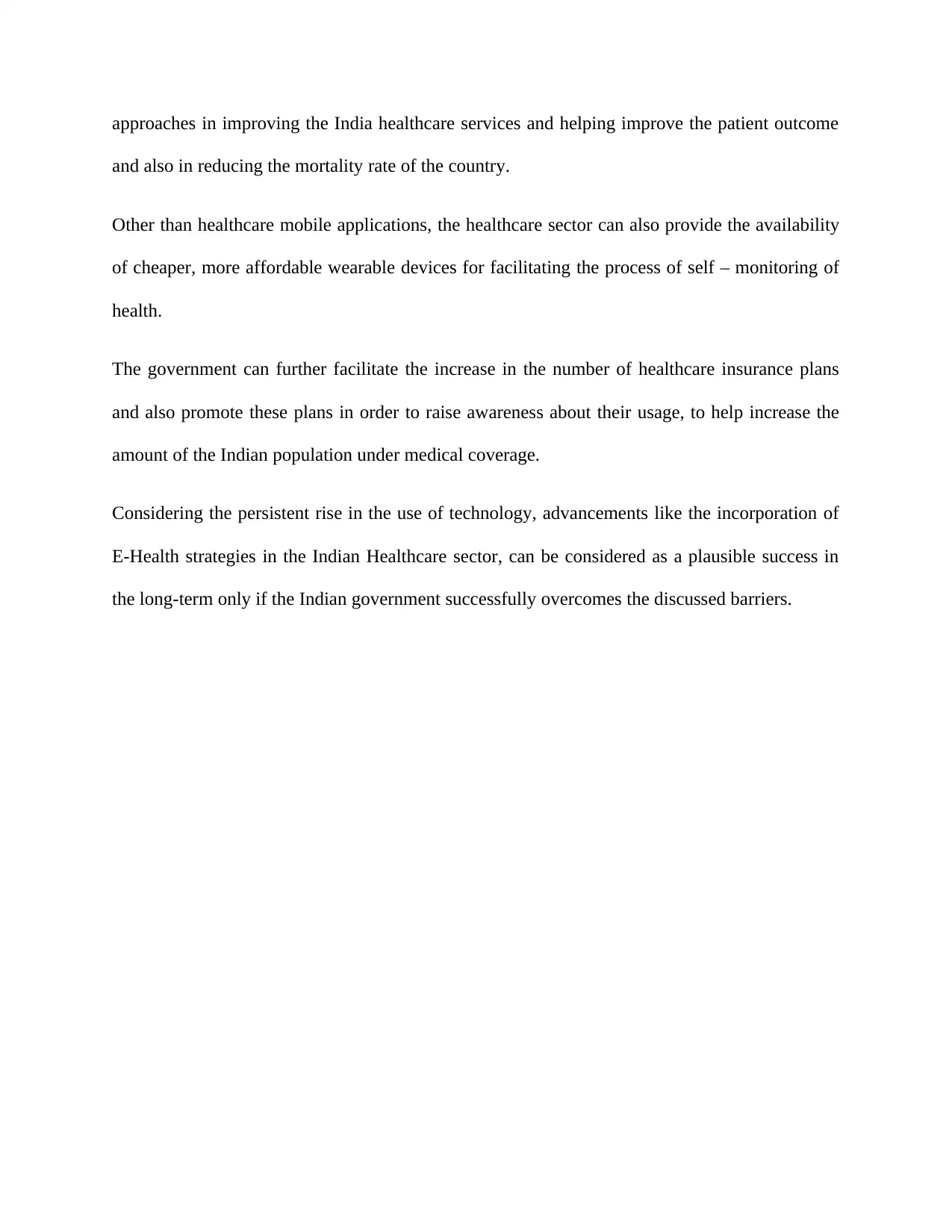
approaches in improving the India healthcare services and helping improve the patient outcome
and also in reducing the mortality rate of the country.
Other than healthcare mobile applications, the healthcare sector can also provide the availability
of cheaper, more affordable wearable devices for facilitating the process of self – monitoring of
health.
The government can further facilitate the increase in the number of healthcare insurance plans
and also promote these plans in order to raise awareness about their usage, to help increase the
amount of the Indian population under medical coverage.
Considering the persistent rise in the use of technology, advancements like the incorporation of
E-Health strategies in the Indian Healthcare sector, can be considered as a plausible success in
the long-term only if the Indian government successfully overcomes the discussed barriers.
and also in reducing the mortality rate of the country.
Other than healthcare mobile applications, the healthcare sector can also provide the availability
of cheaper, more affordable wearable devices for facilitating the process of self – monitoring of
health.
The government can further facilitate the increase in the number of healthcare insurance plans
and also promote these plans in order to raise awareness about their usage, to help increase the
amount of the Indian population under medical coverage.
Considering the persistent rise in the use of technology, advancements like the incorporation of
E-Health strategies in the Indian Healthcare sector, can be considered as a plausible success in
the long-term only if the Indian government successfully overcomes the discussed barriers.
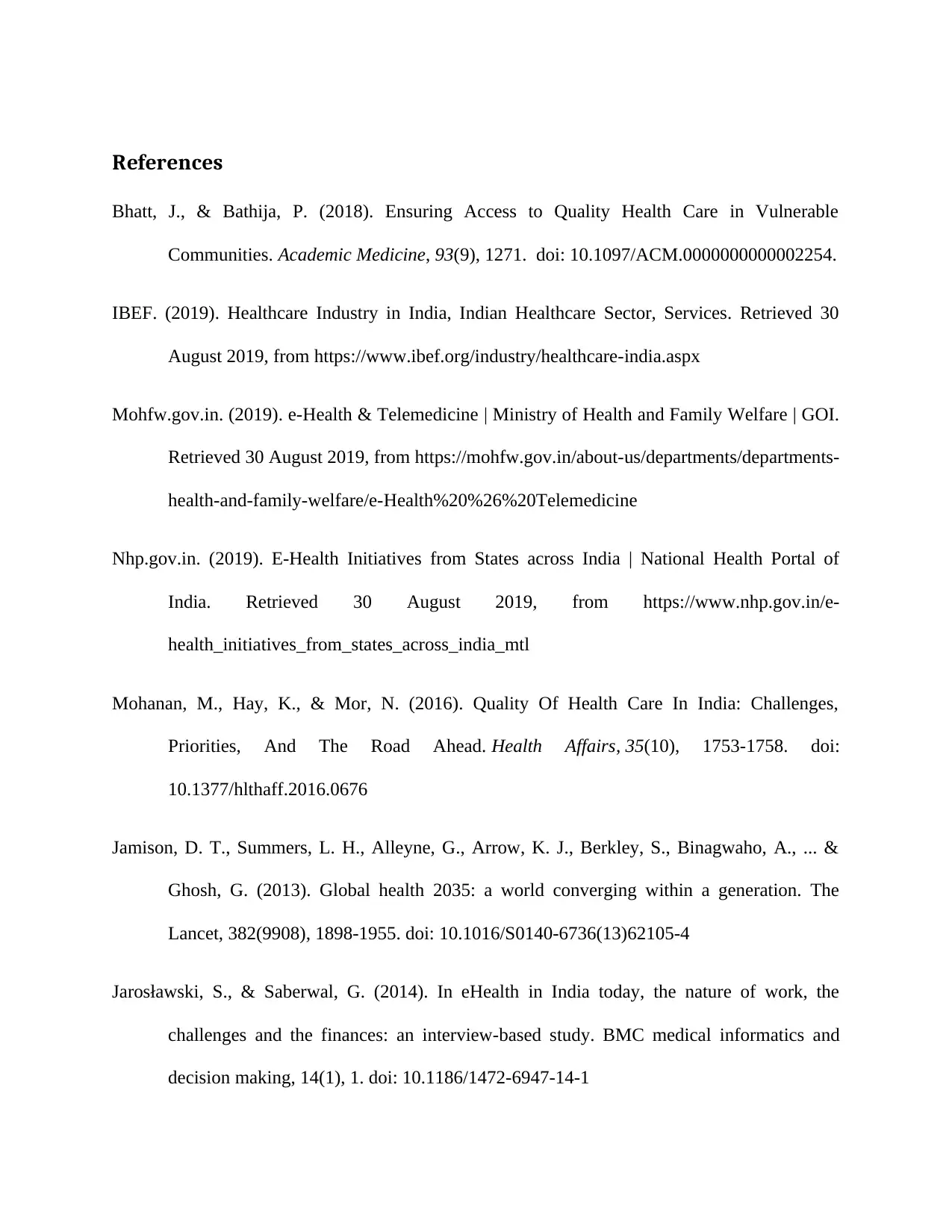
References
Bhatt, J., & Bathija, P. (2018). Ensuring Access to Quality Health Care in Vulnerable
Communities. Academic Medicine, 93(9), 1271. doi: 10.1097/ACM.0000000000002254.
IBEF. (2019). Healthcare Industry in India, Indian Healthcare Sector, Services. Retrieved 30
August 2019, from https://www.ibef.org/industry/healthcare-india.aspx
Mohfw.gov.in. (2019). e-Health & Telemedicine | Ministry of Health and Family Welfare | GOI.
Retrieved 30 August 2019, from https://mohfw.gov.in/about-us/departments/departments-
health-and-family-welfare/e-Health%20%26%20Telemedicine
Nhp.gov.in. (2019). E-Health Initiatives from States across India | National Health Portal of
India. Retrieved 30 August 2019, from https://www.nhp.gov.in/e-
health_initiatives_from_states_across_india_mtl
Mohanan, M., Hay, K., & Mor, N. (2016). Quality Of Health Care In India: Challenges,
Priorities, And The Road Ahead. Health Affairs, 35(10), 1753-1758. doi:
10.1377/hlthaff.2016.0676
Jamison, D. T., Summers, L. H., Alleyne, G., Arrow, K. J., Berkley, S., Binagwaho, A., ... &
Ghosh, G. (2013). Global health 2035: a world converging within a generation. The
Lancet, 382(9908), 1898-1955. doi: 10.1016/S0140-6736(13)62105-4
Jarosławski, S., & Saberwal, G. (2014). In eHealth in India today, the nature of work, the
challenges and the finances: an interview-based study. BMC medical informatics and
decision making, 14(1), 1. doi: 10.1186/1472-6947-14-1
Bhatt, J., & Bathija, P. (2018). Ensuring Access to Quality Health Care in Vulnerable
Communities. Academic Medicine, 93(9), 1271. doi: 10.1097/ACM.0000000000002254.
IBEF. (2019). Healthcare Industry in India, Indian Healthcare Sector, Services. Retrieved 30
August 2019, from https://www.ibef.org/industry/healthcare-india.aspx
Mohfw.gov.in. (2019). e-Health & Telemedicine | Ministry of Health and Family Welfare | GOI.
Retrieved 30 August 2019, from https://mohfw.gov.in/about-us/departments/departments-
health-and-family-welfare/e-Health%20%26%20Telemedicine
Nhp.gov.in. (2019). E-Health Initiatives from States across India | National Health Portal of
India. Retrieved 30 August 2019, from https://www.nhp.gov.in/e-
health_initiatives_from_states_across_india_mtl
Mohanan, M., Hay, K., & Mor, N. (2016). Quality Of Health Care In India: Challenges,
Priorities, And The Road Ahead. Health Affairs, 35(10), 1753-1758. doi:
10.1377/hlthaff.2016.0676
Jamison, D. T., Summers, L. H., Alleyne, G., Arrow, K. J., Berkley, S., Binagwaho, A., ... &
Ghosh, G. (2013). Global health 2035: a world converging within a generation. The
Lancet, 382(9908), 1898-1955. doi: 10.1016/S0140-6736(13)62105-4
Jarosławski, S., & Saberwal, G. (2014). In eHealth in India today, the nature of work, the
challenges and the finances: an interview-based study. BMC medical informatics and
decision making, 14(1), 1. doi: 10.1186/1472-6947-14-1
⊘ This is a preview!⊘
Do you want full access?
Subscribe today to unlock all pages.

Trusted by 1+ million students worldwide
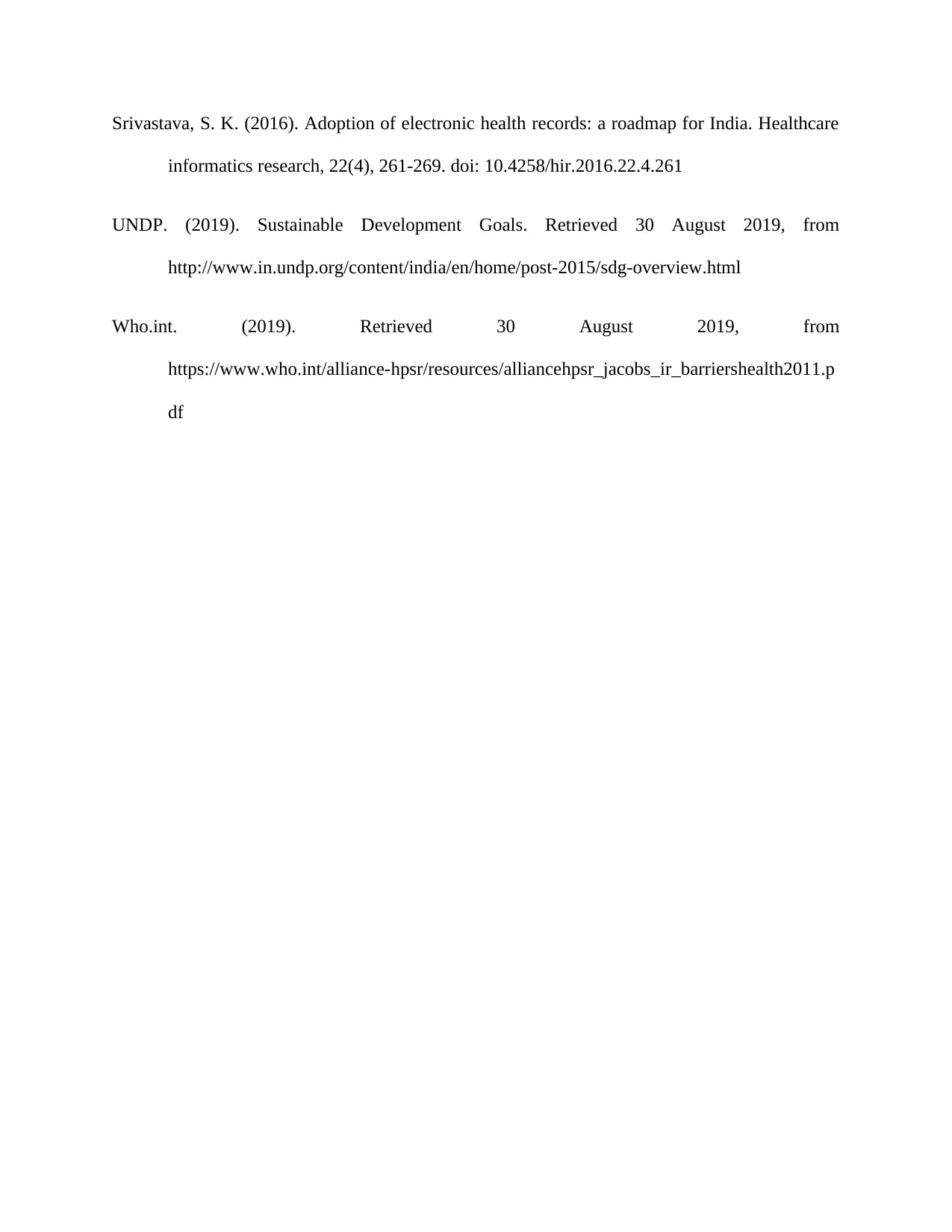
Srivastava, S. K. (2016). Adoption of electronic health records: a roadmap for India. Healthcare
informatics research, 22(4), 261-269. doi: 10.4258/hir.2016.22.4.261
UNDP. (2019). Sustainable Development Goals. Retrieved 30 August 2019, from
http://www.in.undp.org/content/india/en/home/post-2015/sdg-overview.html
Who.int. (2019). Retrieved 30 August 2019, from
https://www.who.int/alliance-hpsr/resources/alliancehpsr_jacobs_ir_barriershealth2011.p
df
informatics research, 22(4), 261-269. doi: 10.4258/hir.2016.22.4.261
UNDP. (2019). Sustainable Development Goals. Retrieved 30 August 2019, from
http://www.in.undp.org/content/india/en/home/post-2015/sdg-overview.html
Who.int. (2019). Retrieved 30 August 2019, from
https://www.who.int/alliance-hpsr/resources/alliancehpsr_jacobs_ir_barriershealth2011.p
df
1 out of 10
Related Documents
Your All-in-One AI-Powered Toolkit for Academic Success.
+13062052269
info@desklib.com
Available 24*7 on WhatsApp / Email
![[object Object]](/_next/static/media/star-bottom.7253800d.svg)
Unlock your academic potential
Copyright © 2020–2025 A2Z Services. All Rights Reserved. Developed and managed by ZUCOL.





